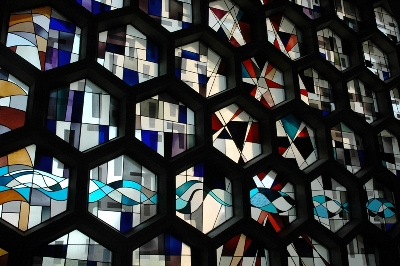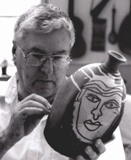Welcome to the Bak Art Virtual Museum, sponsored by the Bronislaw and Hedi Bak Art Legacy Project, an on-going effort to bring before the public the works of two prolific and unique artists. This effort involves family, friends of the artists, colleagues and many who never knew them, but have been inspired by their work over the years.
One of the myths about the arts is that importance of artist's work is discovered long after they pass away. That does happen occasionally, but the more likely outcome is that as artists pass, even important ones, the memory of their time among us and the knowledge of their legacy fades. Over their years many of their paintings, fine prints and self-published books and even large architectural commissions such as stained glass windows and sculpture have passed on to new owners, with little or no idea about the history of these artists and their accomplishments. Bronislaw and Hedi Bak are among such artists.
Bronislaw Bak designed and executed the massive stained glass window wall in St. John's Abby Church in Collegeville, Minnesota in 1961. Leading a team of students and monks who he trained, they built in a two year period what is considered one of the largest such works in the world. Just given the size of the work and the complexity and beauty of the design, his accomplishment should have propelled him to fame during his time. Even today, while there are many images of the window on the internet, very few give any credit to the designer and man who led the construction of this massive work of art.
Leading a team of students and monks who he trained, they built in a two year period what is considered one of the largest such works in the world. Just given the size of the work and the complexity and beauty of the design, his accomplishment should have propelled him to fame during his time. Even today, while there are many images of the window on the internet, very few give any credit to the designer and man who led the construction of this massive work of art.
Hedi Bak was a prolific printmaker, painter and educator. While working as a conservator at the Gutenberg Museum in Mainz, Germany, she was tasked with printing the first edition of prints from the newly rediscovered illustration blocks of the Luther Bible. Bruno and Hedi's lives intersected World War II, immigrant life of artists in America - the south and the midwest and in Hedi's case even Africa.
The Bak Art Legacy Project has as it's objectives:
-
-
- Develop a thorough presentation of their work - an on-line catalog
- Research, archive, photograph art work, primary source articles and letters
- Educate the public about the artists' history, accomplishments and the context of their work
- Establish a point of contact for museum curators, scholars and owners of Bak work to validate work
- Provide works from the collection for inclusion in museum and school exhibitions
- Create awareness for the long term preservation of their works
The origins of the project began in 1984, shortly after Hedi Bak suffered a massive stroke and lost her ability to walk. It was only a few years since Bronislaw died unexpectedly from a heart attack, and she was in danger of losing her home and studios right off the campus of Georgia Southern in Statesboro Georgia.

With hundreds of works of art in danger, a committee was formed led by many faculty members, friends and neighbors. Clemens Bak, the son of the artists was elected secretary and represented the family. An agreement was struck with the College, to move the work into temporary storage on campus. The Library at Georgia Southern offered to keep Bronislaw's papers and also ended up with a considerable collection of prints and several paintings. The rest was moved to Atlanta, where Hedi and her sons and their families settled. Soon after work began on the biography. The book published on this site began as collaboration between Clemens and Hedi, Bak; a result of many hours of recordings and a a study trip to Germany in 1991.
A number of close friends and colleagues, many who have since passed away wrote lengthy letters documenting their memories of the Baks that are now in the archives. Many of these memoirs are part of this book as well. In 1992, the late Keith Rasmussen, artist and museum director at the La Grange Museum of Art organized an exhibit of 50 works on paper which opened in April 1993 in La Grange and went on to show in 8 other museums and colleges in the South.

In later life, after her husband died, Hedi Bak met and married the artist, Charles Counts . Charles was a well established potter, author and educator in Georgia and a fellow of the American Crafts Council who died while teaching in Africa in 2000. His life, both here in Georgia and for many years in Northern Nigeria is also sigificant. Hedi and Charles lived in Africa for nearly 10 years off and on, teaching and sharing their lives with young African artists. During their one of their trips back, Hedi and Charles established a workshop in Oak Ridge, Tennessee. Beaver Ridge Pottery and Gallery was home base for both artists for several years. Mathew Bak moved to Oak Ridge and took up residence in the workshop and maintained it while they were in Africa.
In a small village about 30 kilometers from Maiduguri in Northern Nigeria, Charles and Hedi founded a Pottery Centre, to encourage the continuation of thetraditional crafts. Nigeria like all of Africa has been inundated by cheap commercial plastic and metal cooking pots. The threat of losing the knowledge and ability to sustain a family on the sale of pottery is real. The Centre was designed to allow traditional women potters from remote villages to spend several weeks as a group at the centre, learning and teaching pottery skills. Charles' students from the University of Maiduguri would spend time at the center and help teach these skills. Charles' legacy in Africa is as widely known there as is his many years as pre-eminent potter and author here in the South.
This project, like this website is a work-in-progress. With the support of patrons of the Bak Legacy, we have been able to finally assemble much of the information we have and have begun to bring this before the public. The ultimate goal of the Bak Art Legacy Projectis to find a permanent institutional home for the collection where future generations can learn about their lives and become aware of their legacy. If you are interested in helping this effort contact us here.

















 Leading a team of students and monks who he trained, they built in a two year period what is considered one of the largest such works in the world. Just given the size of the work and the complexity and beauty of the design, his accomplishment should have propelled him to fame during his time. Even today, while there are many images of the window on the internet, very few give any credit to the designer and man who led the construction of this massive work of art.
Leading a team of students and monks who he trained, they built in a two year period what is considered one of the largest such works in the world. Just given the size of the work and the complexity and beauty of the design, his accomplishment should have propelled him to fame during his time. Even today, while there are many images of the window on the internet, very few give any credit to the designer and man who led the construction of this massive work of art. 